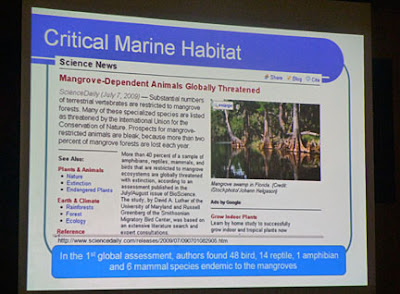Today, Shufen gave a talk about our mangrove forests as part of NPark's “Forests, People, Environment” Exhibition at the Singapore Botanic Gardens.
I learnt a lot about our mangroves today!
Shufen gave a very thorough talk discussing tricky issues such as: what is a mangrove? The tree or the ecosystem? She explains that we should use 'mangrove forest' when referring to the ecosystem to avoid confusion. She also discusses: what is a 'true mangrove'? She outlines some of the key characteristics, based on Tomlinson. It appears this is still an ongoing issue and the status of many plants are still being discussed.
Mangroves are hard core plants! They thrive in super harsh conditions. Squishy ground with little oxygen and drowned everyday in salty water! Shufen then explains the mangroves unique adaptations to deal with these situations. Resulting in some curious and intriguing characteristics of mangrove trees. Such as their roots, the way they reproduce, and more!
Shufen then highlights some of the important roles of mangrove forests. The list is quite long and impressive!
Mangrove forsts are homes to a wide variety of animals. Shufen explained that while we might think some animals are equally at home in mangrove forests and adjacent more terrestrial habitats, a study found that many large animals depend on mangrove forests for at least part of their life cycle. The loss of mangroves would affect these mangrove-dependent animals!
Do mangrove forests protect the coast from tsunamis and storms? Shufen explains that more study is needed. But what is clear is that different kinds of roots and tree structures have different effects in cushioning the impacts of extreme weather. Thus it is important to conserve the diversity within the mangrove forest.
Mangrove forests provide important livelihood for coastal dwellers in our region and is the source of some of our favourite seafood! No mangroves=no seafood!
Shufen also gave some insights to our very own mangroves. Sadly, we have lost a lot, as indicated in these maps from the Guide to Mangroves of Singapore. How much do we really have left? Shufen says it really depends on the methods used to measure mangrove forests.
But we still have some amazing mangrove forests. Shufen gives us a glimpse into some of them. Such as the mangrove forests in the Western Catchment which is part of the Live Firing Area. Wow, the trees there are very tall!
There is also a 'lake' with mangroves at Pulau Tekong! It is here that the Tumu berau (Bruguiera sexangula) was rediscovered in 2005.
While we might imagine that our mangrove forests are poor shadows of those elsewhere in the region and that it doesn't matter if we have them or not, Shufen highlights that some globally important trees are found in Singapore's mangrove forests! Among them the Bakau mata buaya (Bruguiera hainesii). Globally, there are believed to be only about 200 trees. Singapore has four!
There are of course lots of animals in our mangrove forests. And scientific study, such as those done by Dr Patrick Grootaert, reveals many new to science, right here in Singapore! Here's a post about a talk given by Dr Patrick Grootaert some time ago. Shufen highlighted the awesome website of Empidoidea of Singapore Mangroves!
In land-scarce Singapore, Shufen explains that we have to come up with creative solutions to conserve mangroves. She highlighted the effort to replant mangroves at Pulau Semakau following the construction of the Landfill there. As well as the efforts to restore the mangroves at Pulau Tekong.
Meanwhile, there is a lot that ordinary people can do! Visit our mangroves: at Sungei Buloh, Pasir Ris, Pulau Ubin, Chek Jawa and Pulau Semakau.
Join ongoing efforts to deal with some of the issues affecting our shores and mangroves. International Coastal Cleanup Singapore is now in its 20th year and the annual clean up will happen this September. They will be doing a mangrove clean up at Lim Chu Kang on 6 Aug.
Shufen also highlights the Mega Marine Survey as a fun and meaningful way for anyone to contribute to learning more about our mangrove forests.
Here's MORE ways for ordinary people to make a difference for mangroves!
Shufen also highlights the awesome guides done by Dr JWH Yong which he has kindly allowed me to upload on wildsingapore flickr for your viewing and download. More about Dr Yong and his guides on the Celebrating Singapore's Biodiversity blog.
Shufen ends with a list of some useful references. Some of these are also listed on this wildfact sheet on mangroves. Shufen, of course, covered a lot more that I didn't cover in this short post.
This is the last of the series of many biodiversity talks! I sure learnt a lot from them!
I also had a great time sharing about our shores at yesterday's talk with a very obliging audience!
In the upcoming week, I'll be giving more talks about our shores! It's always nice to share about our shores and hear from thoughts and ideas about what we can do for them!




















